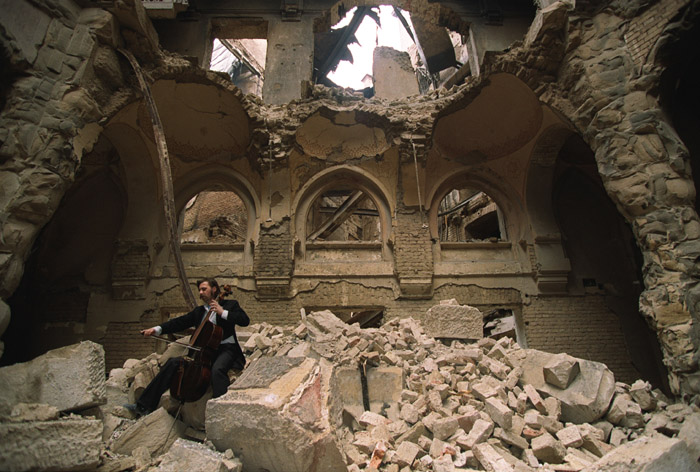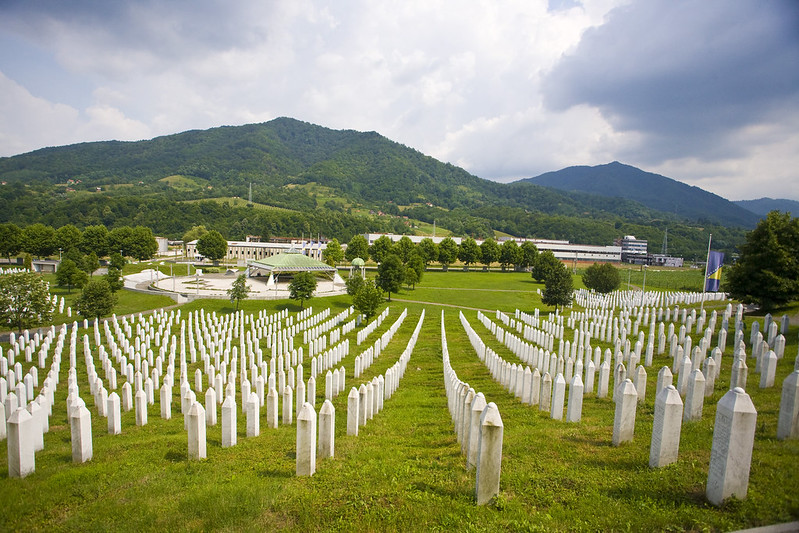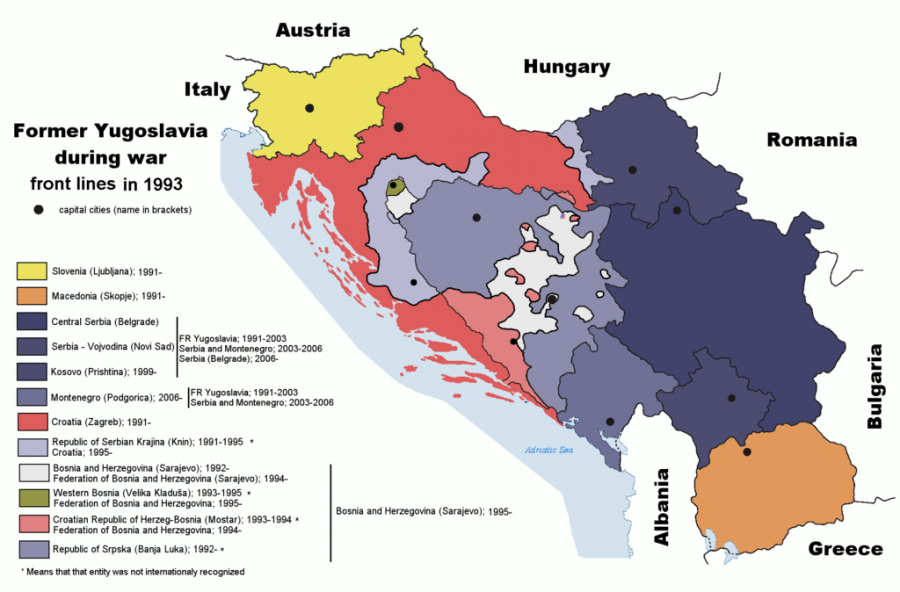During the Bosnian War (1992-1995), Serbian troops massacred thousands of Muslim civilians at Srebrenica; this crime has been recognized as a genocide.
Precursors to the Genocide
Yugoslavia
From 1945 to 1992, Bosnia and Herzegovina formed part of the socialist Federal Republic of Yugoslavia, along with five other Balkan states: Serbia (which included the independent region of Kosovo), Croatia, Macedonia, Montenegro, and Slovenia.
A number of different ethnic groups made up the Yugoslavian population. Following the death of President Josip Tito in 1980, each group began advocating for independence. This was especially the case for Serbs, whose nationalism was growing with the popularity of Slobodan Milošević in Serbia and Radovan Karadžić in Bosnia and Herzegovina (see below).
Milošević was elected president of Serbia in 1989. He incited Serbian nationalism in the other republics with the goal of creating a unified “Greater Serbia”.
In 1991, with the fall of communism and the dismantling of the Eastern Bloc, Croatia and Slovenia declared independence.
Catalysts for the Genocide
In 1991, in his address to the Bosnia and Herzegovina parliament, Serb leader Radovan Karadžić hinted at the disappearance of Bosniaks if Bosnia and Herzegovina ever became an independent state. A few months later, Karadžić became the first president of the Serbian Republic of Bosnia and Herzegovina. Bosnia declared its independence after a referendum vote on April 5th 1992. In retaliation for this unwanted referendum result, Bosnian Serb troops launched an assault on the capital of Sarajevo, claiming the lives of an estimated 5,000 civilians until the siege was lifted in 1995.
Serb forces attacked other predominantly Serb territories and carried out a reign of terror to expel Croats and Bosniaks. In addition to these massacres, Serbs attacked Bosniak culture by destroying major institutions and burning books, rare manuscripts, and historical archives. At this time, the United Nations peacekeeping force UNPROFOR was on the ground to provide humanitarian aid and protect six demilitarized “safe haven” enclaves for Bosnian civilians (in Sarajevo, Bihac, Zepa, Gorazde, Tuzla, and Srebrenica). However, the UN refused to intervene in a military manner.
As early as August 1992, the existence of Serbian concentration camps became public and the world began to recognize these crimes as genocide.

The Bosnian Genocide
One assault after another, Serb forces captured and “ethnically cleansed” regions. The term “ethnic cleansing” refers to the eradication of Bosniak civilians by Serb forces. The objective was to ethnically purify the territory. The rape of Bosniak women was one of the “cleansing” war tactics.
Srebrenica was located in the territory of the Bosnian Serb Republic and had been a Bosniak enclave under UN protection since May 1993. A battalion of nearly 400 Dutch peacekeepers were stationed there. Besieged since 1992, the town had 44,000 residents, half of whom were refugees.
On July 11, 1995, Bosnian Serb troops, led by Ratko Mladić and supported by Milošević’s Serbian government, seized Srebrenica, ordered the departure of peacekeepers, and carried out the ethnic cleansing of Bosniaks. Families were separated: men were forced to remain while women and children were boarded on buses and deported. More than 20,000 people were forcibly displaced and sent to Bosnian-held territory.
From July 11 to 16, 1995, 8,372 men and boys in the enclave were killed. They were shot or beheaded and buried in mass graves. These were the worst atrocities committed in Europe since the Second World War.
End of Conflict
The conflict ended in 1995 following an offensive in Croatia and intervention by NATO. The Dayton Accords were signed on December 14, 1995. This peace agreement divided Bosnia and Herzegovina into two autonomous states: the Federation of Bosnia and Herzegovina (Croat-Bosniak) and the Bosnian Serb Republic. Approximately 100,000 people were killed during the Bosnian war and genocide. As many civilians as soldiers lost their lives and the majority of civilian victims were Bosniak. In addition, more than 2 million people were displaced and became refugees.

Srebrenica Genocide Memorial. © Mike Norton
Justice
Between 1993 and 2017, the International Criminal Tribunal for the Former Yugoslavia (ICTY) tried several officials:
- Radislav Krstić, former commander of the Serb forces in Srebrenica, sentenced to 11 years in prison for complicity in a genocide;
- Slobodan Milošević, former president of Serbia, who died before being formally charged;
- Radovan Karadžić, former president of Bosnian Serbs, sentenced to life imprisonment for committing genocide, war crimes, and crimes against humanity;
- Ratko Mladić, former commander-in-chief for the Bosnian Serb Republic, sentenced to life imprisonment for committing genocide and crimes against humanity.
Recognition of the Genocide
On February 26, 2007, the International Court of Justice (ICJ) formally recognized the Srebrenica massacre as a genocide. In June 2007, a complaint was filed on behalf of survivors and family members of victims of Srebrenica against the Netherlands and the United Nations for their “failure to prevent genocide” and “failure to report war crimes”. On June 27, 2017, the Hague Court of Appeal ruled that the Dutch government was partly responsible for the murder of 350 men and boys during the Srebrenica massacre.

